To guarantee perfect dried tea herbs, aim for a moisture content between 5% and 10%. This range preserves vibrant flavors and aromas while reducing the risk of mold and spoilage. Too much moisture can cause quality degradation, leading to unpleasant flavors and loss of color. On the other hand, insufficient moisture makes the herbs brittle and compromises their taste. Use moisture meters for accurate measurements, and consider proper drying techniques to achieve this ideal level. Curious about the best ways to store your dried tea herbs or how to create herbal blends? There's more to discover!
Importance of Moisture Content
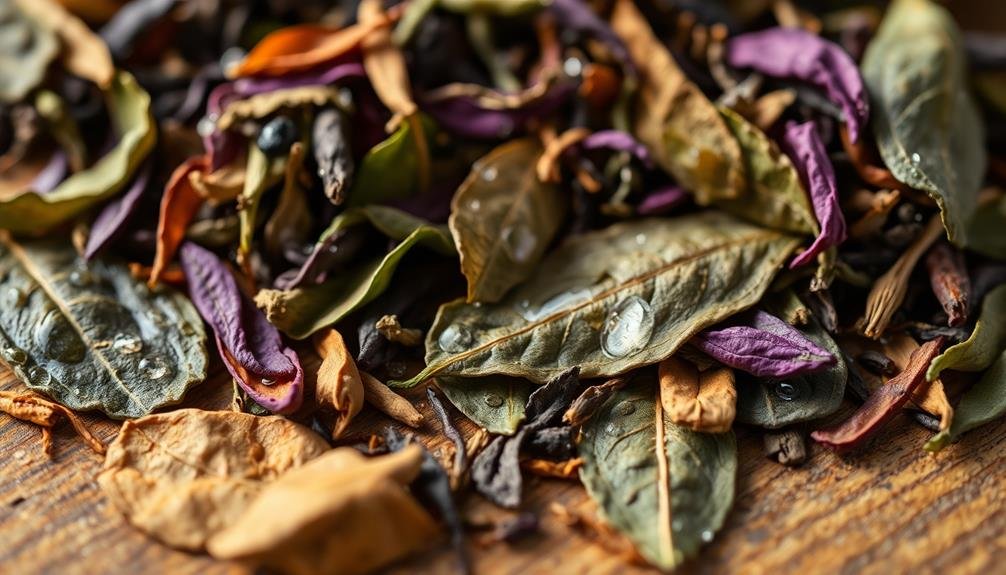
The moisture content in dried tea herbs plays a crucial role in determining both quality and shelf life. When you're selecting or preparing your dried tea, you can't overlook this aspect. Too much moisture can lead to mold and spoilage, while too little can cause the herbs to become brittle and lose their flavor. This balance directly affects the aromatic compounds in your tea, which are fundamental for a satisfying brew.
If you notice your dried tea herbs are losing their vibrant color or aroma, it's likely due to improper moisture levels. This deterioration can also result in a less enjoyable taste, making your tea-drinking experience far from perfect. Additionally, high moisture content can compromise the herbs' health benefits, reducing the overall effectiveness of the tea.
You'll want to store your dried tea herbs in an airtight container, away from light and heat, to maintain ideal moisture levels. Regularly checking the herbs for signs of moisture or deterioration can prevent potential issues.
Ideal Moisture Levels
Maintaining an ideal moisture level between 5% and 10% is essential for preserving the quality of your dried tea herbs. When your herbs fall within this range, they retain their vibrant flavors and aromas while minimizing the risk of mold and spoilage.
If the moisture content is too high, you'll likely face issues like loss of flavor and potential health risks from mold growth. On the flip side, if it's too low, your herbs may become brittle, losing essential oils and aromatic compounds.
To achieve these moisture levels, you'll want to focus on proper drying techniques and storage conditions. Guarantee you're drying your herbs in a controlled environment, away from direct sunlight and humidity.
Once dried, store them in airtight containers in a cool, dark place to maintain that ideal moisture balance. Regularly check your herbs for any signs of moisture imbalance or deterioration.
Methods for Measuring Moisture
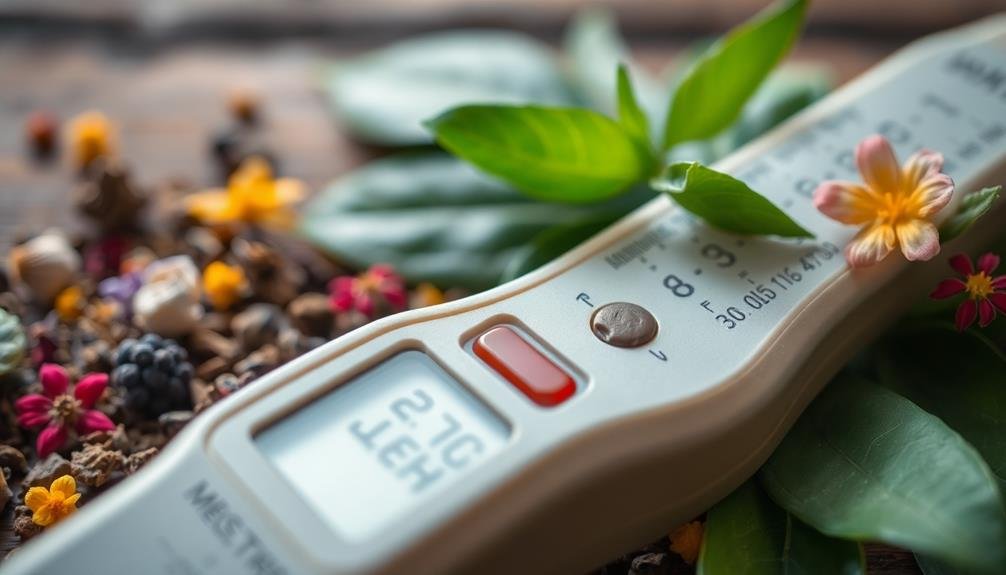
When it comes to measuring moisture in dried tea herbs, you'll find a couple of effective methods at your disposal.
You can use various moisture meter types for quick readings or apply the oven drying technique for a more precise measurement.
Each method has its own advantages, so it's worth exploring both to determine what works best for you.
Moisture Meter Types
Several types of moisture meters are available for measuring moisture content in dried tea herbs, each suited to different needs and preferences.
One popular option is the pin-type moisture meter, which uses metal probes to penetrate the sample. It provides accurate readings but can potentially damage delicate herbs.
If you prefer a non-destructive method, consider a pinless moisture meter. This type uses electromagnetic waves to assess moisture content without any physical contact, making it ideal for fragile tea leaves.
Another option is a capacitive moisture meter. This device measures the dielectric constant of the sample, giving you a quick reading of moisture levels. It's user-friendly and often offers digital displays for easy interpretation.
For those looking for advanced features, smart moisture meters connect to mobile apps, allowing for data tracking and analysis over time. These meters can provide insights for optimizing your drying process.
Ultimately, your choice depends on your specific needs, whether that's accuracy, non-destructiveness, or advanced features.
Oven Drying Technique
The oven drying technique is a reliable method for measuring moisture content in dried tea herbs. This method allows you to obtain accurate readings by removing moisture through controlled heat.
Here's how you can use this technique effectively:
- Prepare the Sample: Weigh a representative sample of your dried tea herbs. Make sure it's clean and free of any contaminants that could affect the moisture reading.
- Dry in the Oven: Place your sample in a preheated oven, typically set between 105°C (221°F) and 110°C (230°F). Keep it in the oven for a specified duration, usually around 2 to 4 hours, depending on the herb and moisture levels.
- Measure the Weight: After drying, remove the sample and allow it to cool in a desiccator. Weigh it again to find the difference in weight. The loss in weight corresponds to the moisture content, which you can calculate as a percentage of the original weight.
Effects of Excess Moisture
Excess moisture in dried tea herbs can lead to significant quality degradation. When herbs retain too much moisture, they become prone to mold and mildew growth. This not only impacts the flavor and aroma but can also pose health risks. If you're storing your herbs in a damp environment, the chances of spoilage increase dramatically.
Additionally, excess moisture can alter the herbal compounds essential for your desired tea experience. You might notice a dullness in flavor or an unpleasant aftertaste, making your tea less enjoyable. The vibrant colors of your herbs can fade, affecting their visual appeal.
Moreover, high moisture content can result in clumping, making it difficult to measure and use your herbs effectively. This can lead to inconsistencies in your brews, leaving you frustrated and dissatisfied with the final product.
To maintain the integrity of your dried tea herbs, it's vital to monitor moisture levels consistently. Keeping your herbs in a cool, dry place will help preserve their quality, ensuring you enjoy a delightful tea experience every time.
Always be vigilant about moisture to protect your investment in quality tea herbs.
Ensuring Proper Drying Techniques
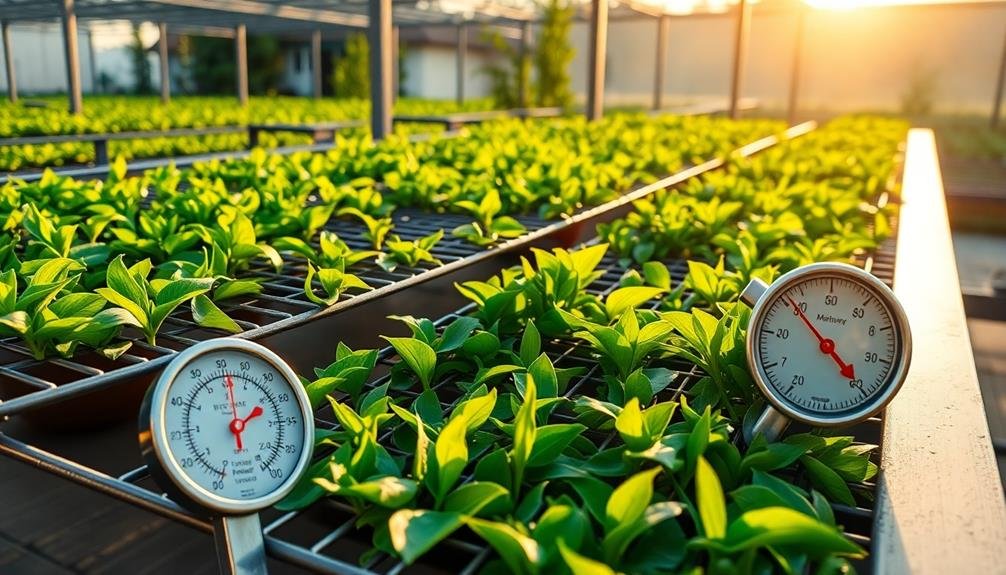
To avoid the pitfalls of excess moisture, it's important to focus on effective drying techniques for your tea herbs. Proper drying not only preserves flavor but also guarantees longevity.
Here are three techniques you should consider:
- Air Drying: Hang your herbs in small bundles in a well-ventilated area, away from direct sunlight. This method is simple and cost-effective, allowing natural airflow to remove moisture.
- Dehydrator: If you want a faster and more controlled method, using a dehydrator is a great option. Set it to a low temperature to maintain the herbs' essential oils and flavors. Check regularly for doneness.
- Oven Drying: For those in a hurry, you can use your oven. Set it to the lowest setting and leave the door slightly ajar to let moisture escape. Keep a close eye on them to prevent scorching.
Best Storage Practices
To keep your dried tea herbs fresh, choosing the right airtight containers is essential.
You should store them in a cool, dark place to maintain the ideal temperature range and prevent light exposure.
These simple steps can greatly extend the life and flavor of your herbs.
Airtight Containers Selection
When it comes to storing dried tea herbs, choosing the right airtight container is essential for maintaining freshness and flavor. You want a container that effectively keeps moisture and air out, ensuring your herbs stay vibrant and aromatic.
Here are three key factors to take into account when selecting your airtight container:
- Material: Opt for glass, metal, or high-quality plastic. Glass jars are excellent for visibility and won't absorb odors, while metal tins can offer extra protection from light.
- Seal Quality: Look for containers with a strong, reliable seal. Silicone seals or screw-on lids are great options, as they prevent air from entering and keep your herbs fresh for longer.
- Size: Choose a container that fits your quantity of herbs. Avoid leaving too much empty space, as this can lead to air exposure. Smaller containers for smaller batches can help maintain ideal freshness.
Ideal Temperature Range
What temperature should you aim for to keep your dried tea herbs in top condition? Ideally, you should store your dried tea herbs in a cool, dark place, maintaining a temperature between 60°F and 70°F (15°C to 21°C). This range helps preserve the flavor and potency of the herbs, preventing the essential oils from degrading.
Avoid storing your tea herbs in areas with fluctuating temperatures, such as near ovens or windows. High temperatures can lead to the loss of aroma and taste, while extreme cold might cause condensation, introducing unwanted moisture.
If you're using a pantry or cupboard, make certain it's well-ventilated and free from heat sources. A stable environment not only enhances the longevity of your tea but also guarantees you enjoy the best quality with each brew.
You can also consider using a thermometer to monitor the temperature regularly, making sure it remains within the ideal range. By keeping your dried tea herbs in the right temperature zone, you'll maintain their freshness and enjoy the full benefits they've to offer.
Proper temperature management is key to maximizing your tea experience.
Light Exposure Control
Maintaining the right temperature is only part of the equation for preserving your dried tea herbs; controlling light exposure is equally important.
Light can degrade the quality of your herbs, causing them to lose flavor and potency. To keep your tea herbs in top shape, follow these best storage practices:
- Store in Opaque Containers: Use dark glass or opaque containers to shield your herbs from light. This prevents UV rays from breaking down essential oils and flavors.
- Keep Away from Windows: Don't place your herbs in locations where they're exposed to direct sunlight, such as windowsills. Choose a dark, cool cupboard or pantry instead.
- Consider UV Protection: If you're using clear containers, consider wrapping them in aluminum foil or placing them in a box to further block out light. This extra step can greatly extend the shelf life of your tea herbs.
Tips for DIY Herbal Blends
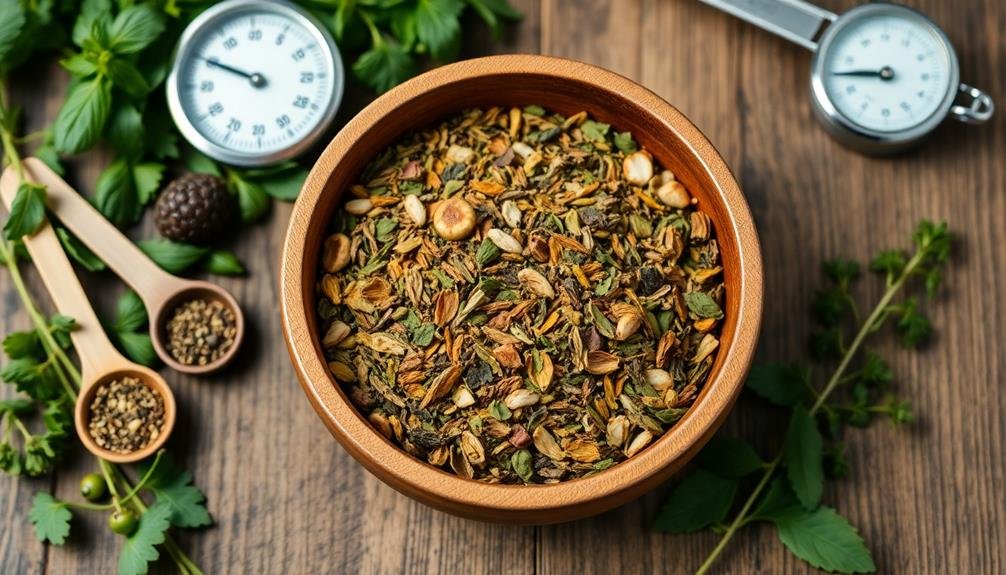
Creating your own herbal blends can be a rewarding experience, and with just a few simple tips, you can elevate your tea game. Start by selecting a base herb, like chamomile or peppermint, which sets the foundation for your blend. Then, contemplate adding complementary herbs to enhance flavor and benefits.
Here's a quick guide to some popular herbal choices:
| Herb | Flavor Profile |
|---|---|
| Chamomile | Sweet, floral |
| Peppermint | Cool, invigorating |
| Lemon Balm | Citrusy, uplifting |
| Lavender | Floral, calming |
| Ginger | Spicy, warming |
Next, experiment with ratios. A good rule of thumb is to start with a 2:1 ratio of base herb to additional herbs. Adjust according to your taste preferences. Finally, don't forget to take into account the moisture content of your herbs. Dried herbs should be crisp but not overly brittle to guarantee the best flavor.
Once you've created your blend, steep it properly to reveal its full potential. Enjoy the process and let your creativity shine!
Frequently Asked Questions
Can I Dry Tea Herbs in a Microwave?
Yes, you can dry tea herbs in a microwave, but it's essential to monitor them closely. Use short intervals to prevent overheating, ensuring they retain their flavor and aroma for the best results.
What Types of Herbs Require Different Moisture Levels?
Different herbs have varying moisture needs. For example, basil thrives with lower moisture levels, while mint prefers a bit more. Experimenting will help you find the ideal balance for each type of herb you're drying.
How Does Humidity Affect the Drying Process?
Humidity impacts the drying process by slowing evaporation, making it harder to achieve ideal dryness. You'll notice that higher humidity levels can lead to mold growth, so controlling the environment is essential for effective drying.
Can I Reuse Dried Herbs After They Lose Potency?
You can reuse dried herbs, but their potency fades over time. Instead of relying on weakened flavors, consider revitalizing your supply or blending with fresh herbs to enhance your dishes' taste and aroma effectively.
What Equipment Is Best for Home Drying Herbs?
For home drying herbs, you'll want to use a dehydrator for efficiency, or an oven on low heat. Hanging herbs in a dark, dry place works too. Just guarantee good airflow to prevent mold.
In Summary
In summary, achieving the perfect moisture content in dried tea herbs is essential for flavor and longevity. Aim for that ideal level of around 8-12% to guarantee your herbs stay fresh and potent. Remember to measure moisture accurately and avoid excess, which can lead to spoilage. By using proper drying techniques and storage practices, you can enjoy vibrant, aromatic herbal blends. So, go ahead and create your own DIY blends with confidence!

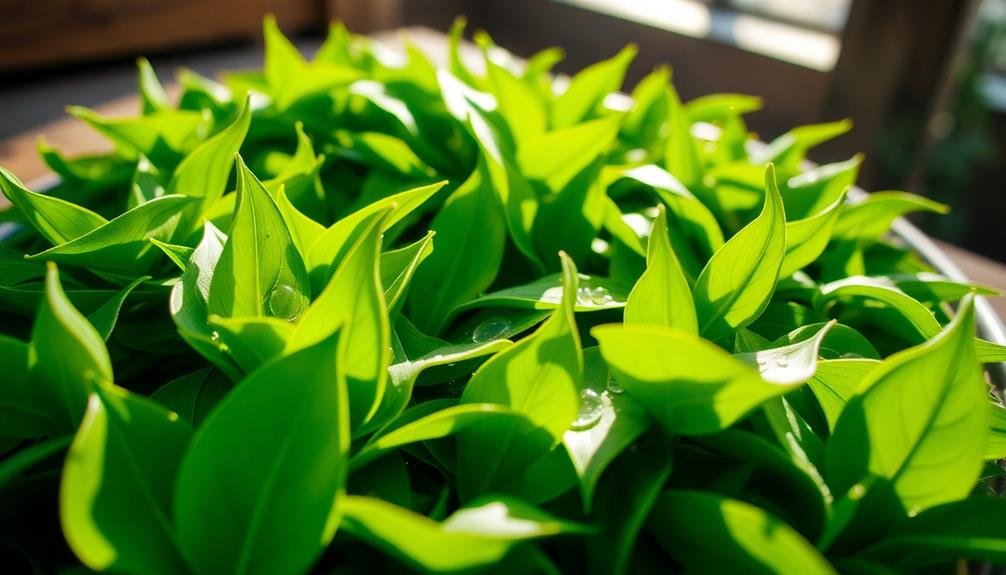
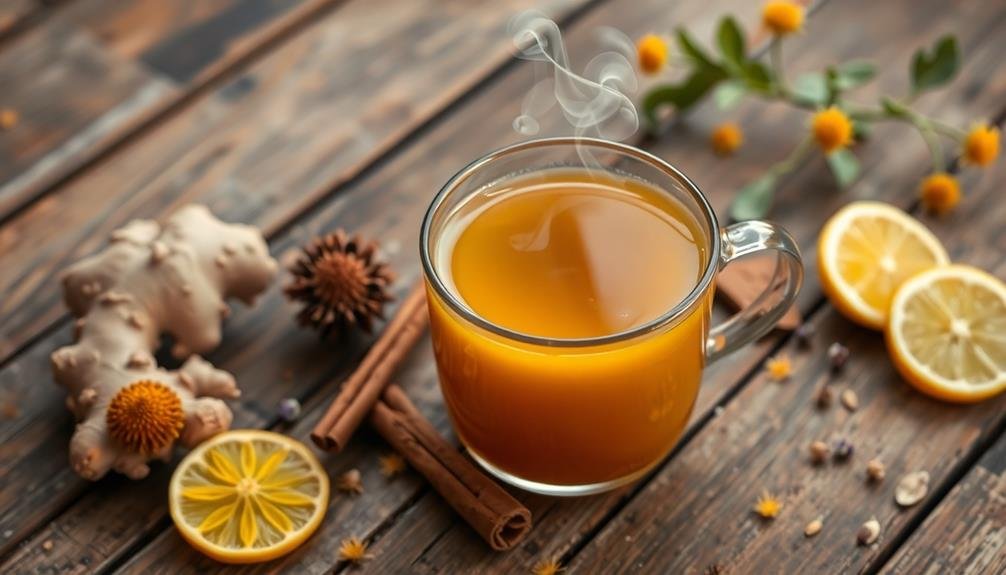
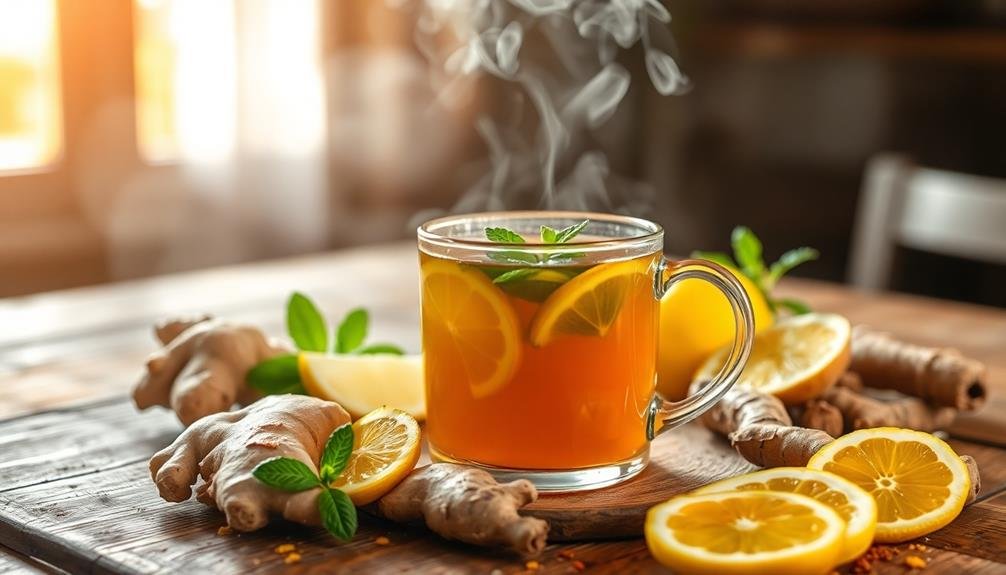
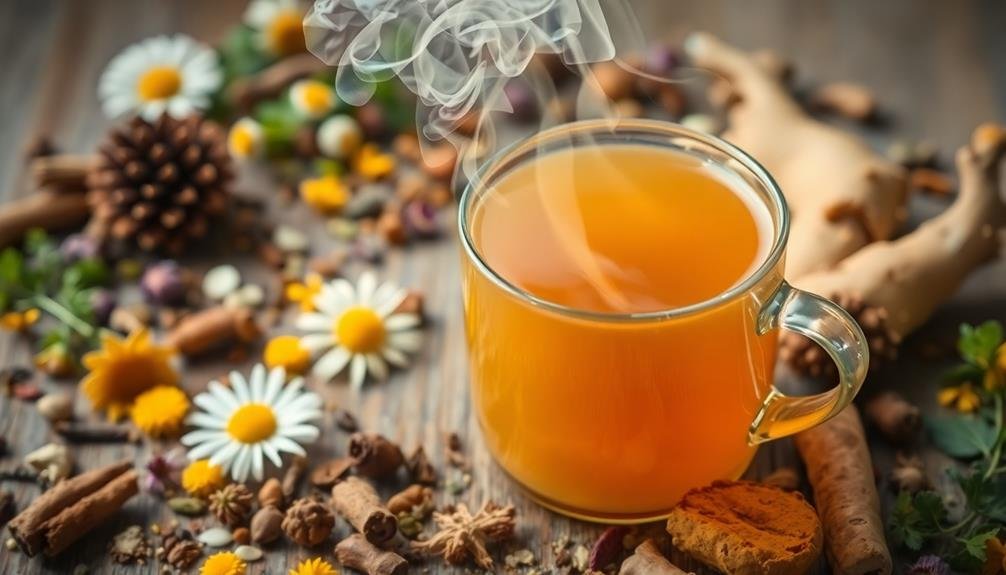
Leave a Reply